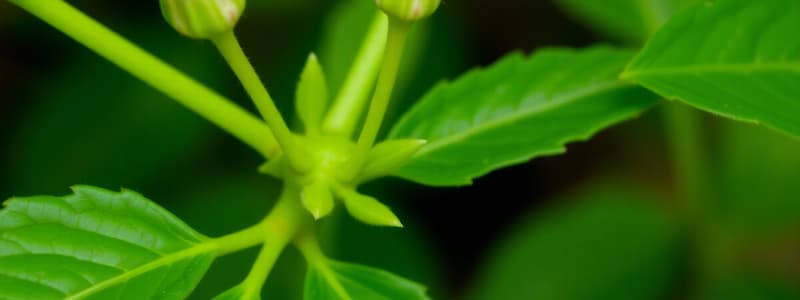Podcast
Questions and Answers
What is the primary method through which asexual reproduction produces offspring?
What is the primary method through which asexual reproduction produces offspring?
- Fertilization
- Gamete fusion
- Meiosis
- Mitosis (correct)
Which cells are involved in sexual reproduction?
Which cells are involved in sexual reproduction?
- Daughter cells
- Gametes (correct)
- Somatic cells
- Stem cells
What is the result of the union of an egg and sperm during sexual reproduction?
What is the result of the union of an egg and sperm during sexual reproduction?
- Zygote (correct)
- Embryo
- Fetus
- Gamete
What initiates puberty in humans?
What initiates puberty in humans?
During which stage of life does adolescence typically occur?
During which stage of life does adolescence typically occur?
What hormone is primarily produced by the testes during puberty?
What hormone is primarily produced by the testes during puberty?
What process involves the release of a mature egg from the ovary?
What process involves the release of a mature egg from the ovary?
What is the typical duration of menstruation?
What is the typical duration of menstruation?
How does the endocrine system influence the changes during puberty?
How does the endocrine system influence the changes during puberty?
What is a common change during puberty in both boys and girls?
What is a common change during puberty in both boys and girls?
Flashcards
Asexual Reproduction
Asexual Reproduction
Reproduction that produces offspring through mitosis, creating identical copies of the parent.
Mitosis
Mitosis
Cell division resulting in two identical daughter cells.
Sexual Reproduction
Sexual Reproduction
Reproduction involving the fusion of gametes (egg and sperm).
Gametes
Gametes
Signup and view all the flashcards
Meiosis
Meiosis
Signup and view all the flashcards
Zygote
Zygote
Signup and view all the flashcards
Puberty
Puberty
Signup and view all the flashcards
Endocrine System
Endocrine System
Signup and view all the flashcards
Ovulation
Ovulation
Signup and view all the flashcards
Menstruation
Menstruation
Signup and view all the flashcards
Study Notes
Asexual Reproduction
- Asexual reproduction relies on mitosis.
- Mitosis creates two identical daughter cells from one parent cell.
- No sex cells or mate is needed.
- Offspring inherit genetic information from only one parent.
Sexual Reproduction
- Sexual reproduction involves the fusion of gametes (eggs and sperm).
- Gametes (eggs and sperm) are produced through meiosis.
- Meiosis reduces the number of chromosomes to half the original count.
- A zygote is formed when the egg and sperm unite.
- The zygote develops into a new organism.
Adolescence
- Follows infancy and childhood growth stages.
- Typically occurs between ages 8-13 (girls) and 9-15 (boys).
- Marks the transition to adulthood as the body stops growing.
- A complex process controlled by the endocrine system.
Puberty
- Initiated by the pituitary gland.
- The pituitary gland releases hormones into the bloodstream.
- Hormones affect growth, sexual development, and metabolism.
- In boys, hormones target testes to produce testosterone.
- In girls, hormones target ovaries to produce estrogen.
Ovulation and Menstruation
- Ovulation is the release of a mature egg from the ovary.
- The egg travels down the fallopian tube to await fertilization.
- Menstruation is the shedding of the uterine lining.
- Menstruation typically lasts 3-5 days.
- Menstrual blood flows from the uterus, through the cervix, and out the vagina.
Puberty Changes
- Growth spurts are common during puberty.
- Sweat glands become more active, leading to new body odors.
- Mood swings and skin changes are also typical.
Studying That Suits You
Use AI to generate personalized quizzes and flashcards to suit your learning preferences.





